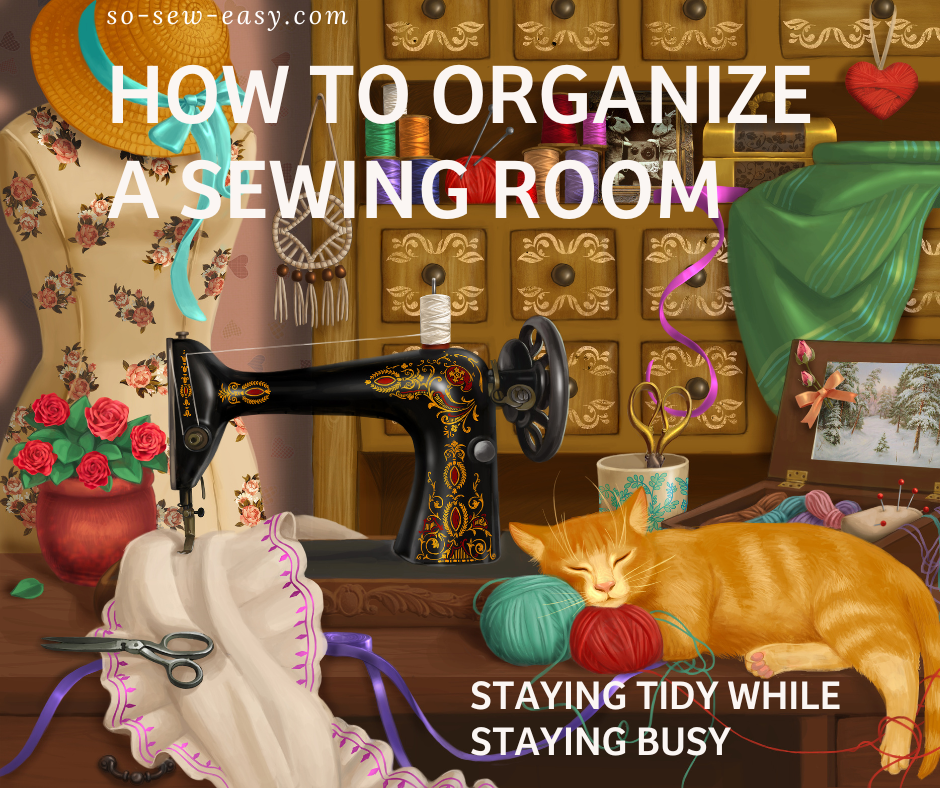
It was a typical Monday morning and I was rushing to get to my sewing studio. I had a long list of projects to complete and knew that every minute counted. As I sat down at my sewing table, I couldn't help but feel overwhelmed by the piles of fabric, patterns, and spools of thread scattered about. It was impossible to find anything I needed and I found myself wasting valuable time searching for a pair of scissors or a spool of matching thread that should have been within arm's reach.
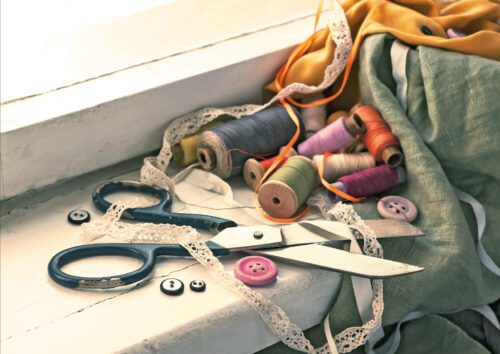

As the day went on, my frustration only grew. I was constantly interrupted by phone calls and friends asking if I had seen this or that fabric. My productivity suffered as I struggled to find the things I needed to complete my projects.


Finally, at the end of the day, I couldn't take it anymore. I decided to take a few minutes to tidy up my sewing space. I sorted through the piles of fabric, put away the patterns, and organized my supplies in a way that made sense to me.
The next morning, as I sat down at my newly organized sewing table, I felt a sense of calm wash over me. I knew exactly where everything was and was able to start my projects immediately. The interruptions from friends and phone calls were fewer and I was able to complete my tasks much more efficiently.
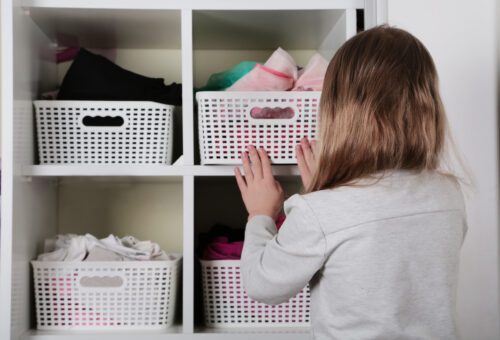

I learned the hard way that a cluttered and disorganized sewing space can be extremely detrimental to productivity and can even lead to increased stress levels. Taking the time to keep your sewing space organized can save you time, energy, and frustration in the long run. It's a simple task that can have a big impact on your workday and overall well-being.
How To Organize Your Sewing Room
Organizing a sewing room can be a daunting task, but with a little planning and some simple strategies, you can transform your space into a functional and efficient work area. Whether you're a beginner or an experienced seamstress, these tips will help you get your sewing room in order and keep it that way.
Assess your needs


Before you start organizing, take stock of your sewing supplies and equipment. Make a list of everything you have and consider what you use most often. This will help you determine what needs to be within easy reach and what can be stored out of the way.
Create a clear workspace
A clean, uncluttered work surface is essential for sewing. Set aside an area for your sewing machine, cutting table, and ironing board, and make sure you have enough room to move around comfortably. Consider using an adjustable-height table or desk to make it easier to work at different heights and angles.
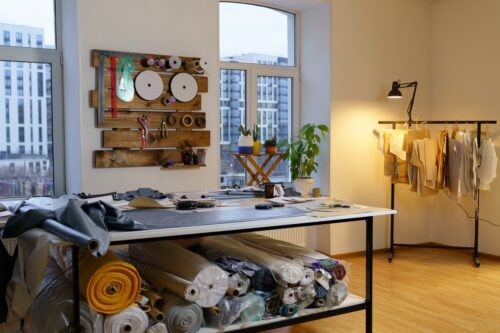

Not everyone has entire rooms free for using as a studio, but do know that space is essential. Depending on how commited you are, I've known people who set up a pair of long picknick tables for temporary workspace in the middle of their kitchens or living room. In certain stages of the sewing process you'll need more or less space, so often times these solutions won't have to be permentant.
Invest in storage solutions
Investing in storage solutions will help you keep your sewing supplies organized and easily accessible. Consider using baskets, bins, or drawers to store your fabric, thread, needles, and other small items. You can also use shelves or racks to keep your patterns, books, and other supplies organized.


Vertical space is often underutilized in sewing rooms, but it's a great way to maximize your storage options. Use wall-mounted shelves or hanging baskets to store your fabric, thread, and other supplies. You can also use pegboards or bulletin boards to keep your patterns and other important documents organized.
Label everything
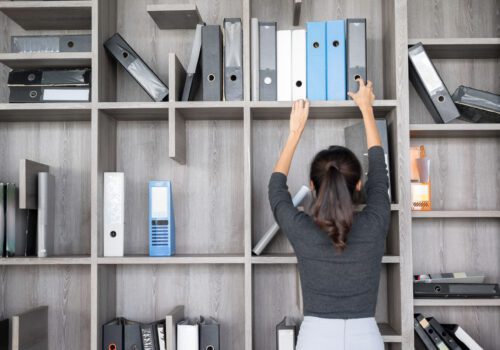

Labeling your storage containers and shelves will help you quickly locate the supplies you need and keep your sewing room organized. Use labels or tags to mark the contents of each container, and consider using a color-coding system to make it easier to find what you're looking for.
Consider using a sewing cabinet or armoire
If you have limited space, a sewing cabinet or armoire can be a great way to keep your supplies organized and out of sight when you're not using them. These pieces of furniture are designed specifically for sewing and often have built-in storage and a surface for your sewing machine.
Keep your sewing machine and tools in good working order
Regular maintenance and cleaning will help keep your sewing machine and tools in good working order and extend their lifespan. Be sure to follow the manufacturer's guidelines for cleaning and maintenance, and consider using a cover to protect your machine when it's not in use. Nothing is more harmful to your productivity than having a machine break down mid-project, or even have one working less than perfectly.
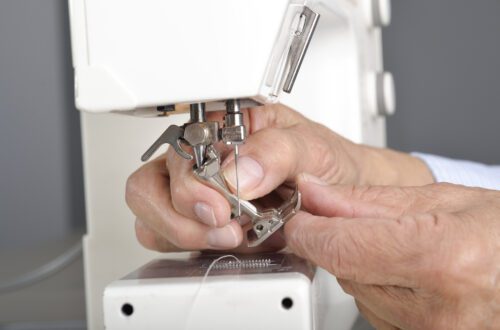

You can take your machine to a dealer shop or intependant professional for a complete deep clean and check-up, or you can follow this tutorial on how to clean your sewing machine.
Create a designated area for sewing projects
Set aside an area for your current sewing projects and keep all the supplies you need for that project within easy reach. This will help you stay focused and avoid the frustration of having to hunt for supplies.


It may uncomfortable for some, but often times a corner of the living room is the perfect spot for a project area. It really is difficult to work when you cannot move around, particularly when you are trying to fit and tailor a garment.
Don't be afraid to declutter


As you organize your sewing room, be sure to get rid of any supplies or equipment that you no longer use or need. Not only will this free up space, but it will also make it easier to find the supplies you do need.
Keep it clean
Finally, be sure to keep your sewing room clean and tidy. Regularly dust and vacuum the space, and consider using an air purifier to help reduce allergens and improve the air quality.


With a little planning and some simple strategies, you can easily organize your sewing room and create a functional and efficient work area. Whether you're just starting out or you're an experienced seamstress, these tips will help you get your space in order and keep it that way.








I still use the old typesetters compartmented drawer that was popular 20 or so years ago to organize my threads spools. Hung on the wall with all of the colorful thread in it, it doubles as artwork. Also I struggled for years to come up with an efficient and economical way to deal with the loose thread ends as many spools and none of the bobbins have a notch for the ends any more. I finally found that the little glue dots from Dollar tree work well for this. Just peel one off of the sheet, and place on top of spool or bobbin pulling the thread underneath the dot near the end of the thread. Keeps it neat, doesn’t unravel, and it’s so cheap to replace!
I’ve been sewing for 55 years, and only learned a couple years ago that the ends of modern spools lift up to create a slot for the thread end. Pop it up on one side, lay the thread into the trough, and then push the end back down. So embarrassing that I didn’t know this, but glad I read about it! You may already know it, but just in case, thought I’d share.
I think it is a great day when we can learn something knew! Thank you for sharing!
This article was perfect timing for the new year! Organizing to become more productive and content in my sewing area was just the inspiration I needed to get going and straighten up and be able to complete unfinished projects because now I can find what I need. As a bonus I can now use my dining room table for dining! Thank you
I live in a fairly small house. My sewing/crafting space is in our guest room. This means that I need to put everything away when we actually have guests. Half the room has my sewing/crafting area, and the other half has a bed and nightstands for guests. Thankfully, there is a closet with enough room for guests to hang anything they need to hang AND for my bins of fabric, and an old dresser where I hide projects-in-process! The only thing I’ve actually had to invest in is a folding table for a work space. Found a great one online; and it can stand folded at the end of the bed – which gives guests a place to put some of their things. Sewing/crafting can indeed happen in a small place.
Amazing! These are great ideas. I try to keep my sewing room straightened, and these ideas should really help. Thank you.
I yesterday doing a tidy up of my sewing room.
Some good tips, thank you for sharing them. I wish I had room for a chair and floor plant in mt craft room, lol.
Happy New Year, my Friends! Thanks for this incredibly timely article on organizing my new sewing space! I’ve been at it for quite awhile now & am drowning in so many articles & approaches that I can’t move. You have provided clear & concise information which doesn’t require spending a fortune! Use what you have & if you don’t use it get rid of it (I’m finally giving myself permission to do this, thanks!) Keep it clean & pamper my machine! What a gem! I’m starting my new year with this gift to myself. THANKS Again! And sew on …